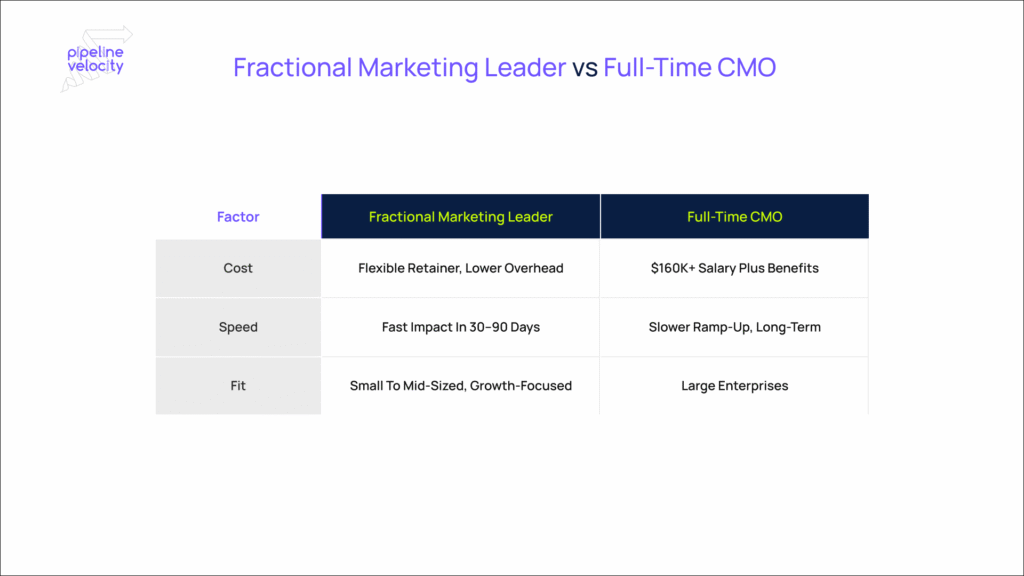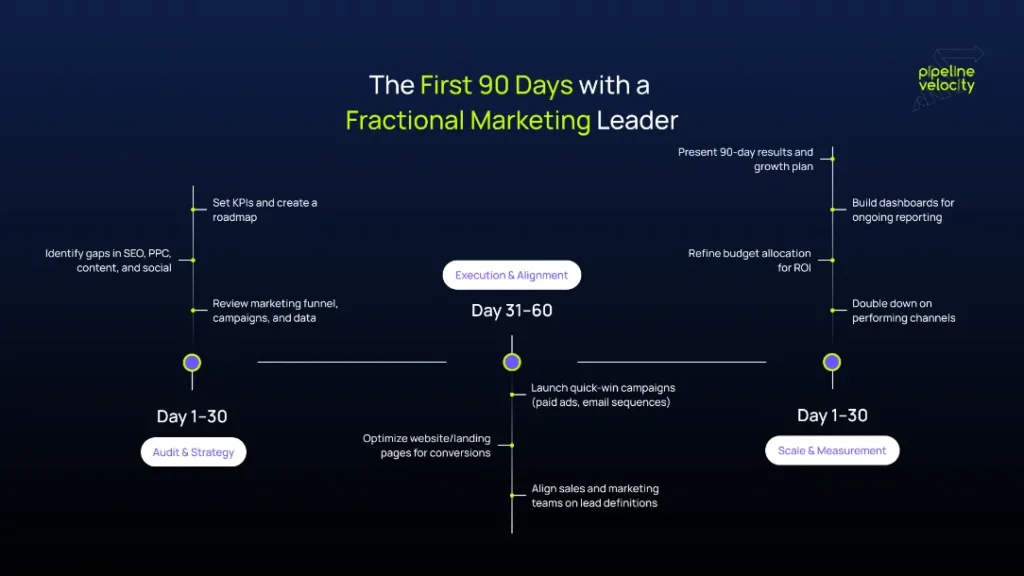Fractional marketing leader demand keeps rising because growth-focused firms want senior judgment without a six-figure payroll burden. A full-time chief marketing officer sits near the top of executive pay bands. The Bureau of Labor Statistics reports the median annual wage for marketing managers at $161,030 as of May 2024, with the top decile far higher, which pushes many midsize companies toward flexible options (BLS). A fractional CMO or fractional marketing director usually runs a monthly retainer that fits founder-led budgets and lets you keep more dollars in media and content. Most companies choose fractional marketing leadership when they need strategic planning, campaign oversight, and revenue accountability without building a large team first. You will pick a full-time CMO when marketing defines your category, requires constant executive airtime, and drives enterprise-level brand bets. Many teams treat outsourcing marketing to a fractional marketing agency as a bridge to full-time leadership. They set clear expertise standards and publish deliverables so progress stays visible.

Our services at Pipeline Velocity plug into fractional leadership
Our services at Pipeline Velocity help founder-led teams install senior marketing leadership without taking on full-time executive overhead. We guide strategy, build scorecards, and stand up a working plan while your team focuses on product and sales. See how our Fractional CMO, Growth Marketing Services, SEO Services, and PPC Management connect leadership with execution. We structure retainer levels so you can flex up during launches and lean during steady quarters. If you prefer a quick diagnostic before a full engagement, we can scope a light audit and a 90-day plan.
What is a fractional marketing leader and how does it compare?
A fractional marketing leader delivers executive-level marketing leadership on a part-time or contract basis. Companies use this role to set marketing strategy, align sales and marketing, and install a modern operating cadence without committing to a full-time chief marketing officer. You get the judgment of a veteran marketing officer, also called a fractional CMO or fractional marketing director, with a right-sized engagement that flexes as your pipeline and product roadmap evolve. The model keeps your spend tied to outcomes and stages, not headcount. You retain control of scope, hours, and objectives while the leader owns planning and measurable delivery. You define expertise requirements and deliverables upfront so the work stays tied to growth goals. For a deeper look at team structure and roles, read our guide to a fractional marketing team.
Defining fractional marketing leader (fractional CMO/directory alternative)
A fractional marketing leader serves as the marketing executive who sets direction, leads planning, and shepherds execution while working a set number of days per month. The leader joins executive meetings, builds the annual and quarterly plans, and drives the marketing team toward revenue targets. Think of this leader as an alternative to a full-time chief marketing officer or an experienced marketing director who acts with C-level accountability. The role pairs seasoned strategy with practical management across channels such as search, paid media, lifecycle email, product marketing, and content. You gain a single accountable owner for the marketing function without taking on permanent executive overhead. The setup fits a startup that needs senior judgment a few days a month.
How this role differs from a full-time CMO or marketing director
A full-time CMO often leads brand, corporate communications, and investor narratives in addition to demand generation and product marketing. That scope suits scale-up and enterprise contexts that require heavy cross-functional coverage. A fractional marketing leader narrows the focus to outcomes that move revenue in the next two to three quarters. You pay for targeted leadership, not broad corporate ownership. Compared to a marketing director who often operates inside a defined playbook, the fractional leader writes the playbook, aligns leadership on tradeoffs, and sets the reporting rhythm. You get senior decision power with less organizational drag and faster iteration. This change resets team dynamics and exposes weaknesses early, so the team corrects course faster.
What are the duties and responsibilities of a fractional marketing leader?

This section lays out the core responsibilities you should expect from a fractional CMO or fractional marketing director. The leader sets strategy, builds the plan, oversees execution, and ties marketing activity to pipeline and revenue. You should expect explicit OKRs, a channel-level budget, a test agenda, and a reporting framework that the CEO and sales leader trust. The right leader coaches your team while selecting and managing agencies or contractors where gaps exist. The leader builds a simple data analytics layer that supports optimization across channels.
Strategic planning and marketing leadership
A strong fractional marketing leader builds a clear growth thesis that ties market insight, positioning, and channel strategy to revenue targets. The leader maps segments, value propositions, and messaging against buyer pains and jobs to be done. They define a channel mix across search, paid media, organic content, social, events, partnerships, and lifecycle email, with budgets that reflect CAC and payback goals. They stand up a quarterly planning cycle that sets goals, experiments, and success metrics. They coach the team, they make hard tradeoffs, and they use weekly reviews to keep focus on the right levers. For planning fundamentals that many small businesses follow, see the SBA’s marketing and sales guidance (SBA). They greenlight a rebranding initiative only when market data proves the story no longer helps sales. They study channel dynamics and call out weaknesses before they drain budget.
Execution oversight vs hands-on involvement
A fractional leader sets the bar for execution quality and holds owners accountable, yet also rolls up sleeves when the team needs lift. The leader writes or edits key briefs, pressure-tests creative angles, and checks targeting and tracking before budgets scale. They build and approve the test-and-learn plan, review dashboards, and call pivots when the data warrants a change. They establish vendor scorecards, set service-level expectations, and ensure each channel shows clear cost per opportunity and cost per acquisition. They keep an optimization backlog and publish deliverables by owner and due date. They step into hands-on work for critical launches, messaging resets, or funnel repairs that cannot wait. If you want a full-funnel blueprint to pair with that execution, our post on building an end-to-end marketing strategy lays out the checkpoints.
How a fractional marketing director supports the marketing team
The fractional marketing director supports the team by clarifying roles, simplifying workflows, and removing blockers that slow progress. The director mentors specialists in content, demand generation, and marketing operations so they can own more of the plan. The director builds an intake process for requests, a prioritization framework that ties backlog to impact, and a calendar that shows ownership and deadlines. The director pairs junior talent with agency partners to raise the quality of output without losing context. The director celebrates wins, builds repeatable templates, and turns good work into standard operating procedures. The director raises data analytics fluency across the team so reporting supports daily decisions.
Bridging marketing strategy, growth, and operational alignment
The best fractional marketing leaders connect strategy to growth muscle and operations. They translate positioning into campaigns that attract, convert, and expand customers. They align sales and marketing through shared definitions for MQL, SQL, SAL, and a service-level agreement for follow-up. They install measurement foundations such as attribution, CRM hygiene, and a single source of truth for pipeline and revenue. They combine high-velocity acquisition with lifecycle programs that protect retention and drive expansion. They run data analytics reviews that lead to optimization across the funnel and healthier team dynamics with sales. They keep finance in the loop on monthly forecasts and they adjust budgets based on real payback, not hope.
Should you consider a fractional marketing leader for your business?
Use this section to decide if fractional marketing leadership fits your stage and goals. Consider your revenue targets, sales motion, team size, and the speed you need to ship a working plan. If you lack a marketing strategy, operate with a small team, and want measurable impact in 90 days, a fractional CMO gives you leverage without delay. This fit holds for a startup that needs senior focus without hiring a full executive bench. If marketing defines your category narrative across investors, analysts, and media, you may benefit more from a full-time chief marketing officer. The right answer hinges on scope, not title.
Signs your business needs flexible marketing leadership
Choose a fractional marketing leader when you run a lean team and need senior guidance now. Pick this path when pipeline fluctuates by season or deal cycle and you need strategic depth a few days per week. Reach for a fractional leader when your channel mix looks scattered, your sales team reports poor lead quality, or your reporting does not show payback. Bring in a fractional CMO when you have agency spend with no owner, when your messaging feels unclear, or when product launches ship without a plan for activation and adoption. If you prefer agency leverage, pair your leader with a fractional marketing agency and assign shared deliverables. Use the role when you value progress and clarity over headcount.
When a full-time CMO still makes sense
Hire a full-time chief marketing officer when your company runs a global brand with constant campaigns, investor relations, and frequent board visibility. Choose a full-time CMO when marketing owns category creation, frequent PR moments, and heavy cross-functional projects. Make the full-time hire when your budgets require daily, high-stakes decisions across multiple regions and product lines. Keep the role in house when you need deep culture building, constant team development, and recruiting at scale. A fractional model can prepare you for this step by installing a plan and proving ROI before you expand the org chart.
Identifying the value of fractional marketing services or fractional CMOs

You care about value, not just titles. Fractional marketing services deliver value through cost control, speed, breadth of pattern recognition, and measurable growth outcomes. The right leader brings a proven approach to segmentation, positioning, channel mix, and measurement. They also bring the judgment to say no to distractions, which preserves budget for the few bets that matter. Value emerges when you see better pipeline quality, shorter sales cycles, and clearer reporting.
Cost-effectiveness and budget advantages
A fractional CMO trims fixed costs and channels more budget into media, content, and tools. You pay for strategy, leadership, and targeted execution hours rather than absorbing a full-time executive package that includes salary, benefits, equity, and overhead. The model fits companies that swing through planning and launch cycles where intensity changes by quarter. You can scale the engagement up or down based on goals and seasonality. You also keep optionality to adjust the mix of in-house staff, contractors, and agencies without carrying a large permanent bench. This model turns outsourcing marketing into a controlled experiment with clear deliverables and a capped budget. For founders weighing what to outsource, we cover tradeoffs in our breakdown of outsourced marketing for small business.
Speed to impact and faster ramp-up
An experienced fractional marketing leader ramps quickly because they carry working frameworks. They walk in with a messaging template, a demand waterfall, channel benchmarks, and a test backlog. They set a 30, 60, and 90-day plan with clear milestones, dashboards, and weekly standups. They cut slow experiments and move budget toward the winners so you see traction faster. Their expertise helps the team skip wheel reinvention and move straight to optimization that shows up in pipeline. They also build internal tools such as a content brief template, a UTM scheme, and a marketing scorecard that speeds future work.
Broader industry perspective and fresh strategy
A fractional leader works across industries, which sharpens instincts and brings new ideas to your market. They borrow conversion patterns from similar customer journeys and they spot waste that hides in habits. They show your team how product marketing, lifecycle programs, and sales enablement work together so buyers see value sooner. They also bring vendor and talent networks that reduce hiring risk and shorten the time between idea and live campaign. That cross-pollination often produces simple changes that raise conversion without large budgets. They also know when a rebranding initiative helps a startup break through and when a light refresh will do. If content drives your funnel, use our checklist to optimize blogs for generative engines.
ROI and business growth outcomes
You should expect measurable ROI from a fractional marketing leader. The leader sets targets for pipeline creation, cost per opportunity, sales velocity, and payback. The leader aligns channel budgets with unit economics and they cut activities that do not move revenue. They connect lifecycle and customer marketing so expansion and retention lift total LTV. They build a board-ready dashboard that shows input, output, and trend so the team makes decisions with confidence. They use data analytics to verify impact and tighten optimization loops. Growth results when focus meets good execution, not when you add more tools.
What are the benefits of hiring a fractional marketing leader?

This section outlines the tangible benefits you will feel across cost, speed, quality of leadership, and continuity. You gain a seasoned marketing officer without the long hiring cycle. You get strategy and execution oversight that fits your current stage, not the stage you might reach next year. You keep flexibility to adapt as product or market shifts. Most of all, you keep your attention on customers while your leader builds the engine that feeds sales.
Scalability and engagement flexibility
The fractional model scales with your goals. You can start with a light engagement to fix positioning and the demand plan, then expand into a broader remit that covers lifecycle and product marketing. You can dial hours up during launches and lean during steady-state quarters. You can add or pause specialist workstreams such as SEO sprints, paid media bursts, or sales enablement pushes. You can combine internal staff with outsourcing marketing for spikes that need extra hands. This cadence suits founder-led companies, private equity rollups, and B2B firms with seasonal cycles. You get senior consistency without rigid staffing.
Avoiding overhead and hidden costs
A full-time executive often introduces hidden costs across HR, recruiting, management time, and the growth of a larger team before you prove ROI. A fractional marketing leader focuses on outcomes and trims the extras. The leader picks the smallest viable team, sets clear work plans, and tracks work against impact. You avoid premature hiring and you direct savings into campaigns and content that convert. You also sidestep long executive searches that slow momentum. The leader exposes weaknesses early and fixes them with process, training, or vendor swaps.
Access to seasoned marketing officers without full-time commitment
With fractional marketing leadership, you gain the experience of a chief marketing officer or a senior marketing director who has shipped dozens of plans. That experience reduces rookie mistakes and compresses the time to a working marketing engine. You get top-tier messaging, channel strategy, and analytics without paying for a permanent executive suite. You keep the relationship focused on outcomes such as pipeline quality, sales enablement, and churn reduction. You also keep the option to convert the relationship later if your scale merits a full-time hire. You also get a library of proven deliverables that reflect hard-won expertise.
Strategic continuity without culture risk
Companies fear that fractional roles create churn, yet strong leaders build continuity. The right leader documents strategy, playbooks, and SOPs so the team runs smoothly. The leader builds a governance rhythm that survives leader transitions. The leader models healthy collaboration with product, sales, and success so culture improves. The leader keeps focus on customers and results, which strengthens morale because people see progress. That environment attracts talent and makes future hires easier. They maintain clean data analytics hygiene so new hires inherit trustworthy reports.
At Pipeline Velocity, we help you execute without extra overhead
At Pipeline Velocity, we help you turn strategy into traction with the right mix of services and senior guidance. When the plan calls for search scale, we pair Integrated PPC and SEO with clean reporting. When you want a health check first, our Marketing Audit Service surfaces gaps and a prioritized roadmap. If you prefer a flexible executive option, our Chief Marketing Officer as a Service keeps leadership tight without adding fixed headcount. Need market depth in a major metro? Our NYC SEO services plug into local demand and national growth.
In summary…, your quick takeaways
Use this summary to confirm fit and next steps. The right choice comes down to scope, timing, and the kind of growth you want in the next few quarters. Keep the decision practical and tied to pipeline and revenue, not titles.
- Fractional marketing leader fit
- Best for lean teams that need senior strategy, faster ramp, and measurable outcomes.
- Works well when budgets favor media and content over permanent overhead.
- Best for lean teams that need senior strategy, faster ramp, and measurable outcomes.
- Full-time CMO fit
- Best for complex portfolios, global brand work, and constant executive visibility.
- Works when you need daily leadership across communications, investor stories, and large teams.
- Best for complex portfolios, global brand work, and constant executive visibility.
- Core value drivers
- Cost control, speed to impact, cross-industry perspective, and reliable ROI.
- Clear OKRs, test plans, and dashboards that keep teams aligned.
- Cost control, speed to impact, cross-industry perspective, and reliable ROI.
- Practical next steps
- Define revenue targets, unit economics, and a 90-day plan with milestones.
- Map the team and vendor mix, then assign owners and timelines.
- Define revenue targets, unit economics, and a 90-day plan with milestones.
Choosing the right marketing leadership sets the tone for growth. If you want a brief assessment of fit and a practical 90-day outline, Pipeline Velocity can walk you through a no-pressure diagnostic and point you to the most efficient plan for your stage.
FAQs
How much does a fractional marketing leader cost compared to a CMO?
A fractional CMO or fractional marketing director usually prices a monthly retainer based on scope and days per month. Many companies spend a fraction of a full-time chief marketing officer’s annual cost and redirect savings into campaigns, content, and tools. A full-time CMO typically requires a high base salary plus benefits and equity, which increases fixed overhead. With fractional marketing leadership, you match spend to your current stage and throttle up during launches or key quarters. You also avoid a long executive search and the risk of a mis-hire.
Can fractional marketing leadership scale as my business grows?
Yes. The model scales through hours, scope, and the mix of in-house talent and agencies. You can start small, prove the plan, and expand the remit to include product marketing, lifecycle, partner marketing, and brand. Many companies increase engagement during launches, then level back during steady quarters. You can also stack roles, such as adding a fractional marketing operations lead to refine reporting and automation. If growth warrants a full-time hire later, you will transition with playbooks and a running engine.
Will a fractional CMO integrate with my existing team and culture?
A strong fractional leader integrates by setting clear goals, roles, and rhythms. They meet with sales weekly, review pipeline and feedback, and translate insight into messaging and campaigns. They coach team members and vendors so output improves without drama. They share dashboards openly and keep meetings short and focused. This approach builds trust and momentum because everyone knows what to do and why it matters.
What’s the typical duration or commitment for fractional services?
Most companies begin with a three to six month engagement that covers discovery, planning, quick wins, and a durable operating cadence. Many renew for another two to three quarters to scale channels and hand off mature programs to internal owners. You can set a scope for a fixed number of days per month and revisit the level quarterly. That cadence balances accountability with flexibility.
How can I measure the impact of a fractional marketing leader?
Measure the leader’s impact through pipeline contribution, cost per opportunity, sales velocity, and payback period. Track improvements in win rate, retention, and expansion revenue as lifecycle programs mature. Review execution health through on-time delivery, test velocity, and vendor performance. Watch for clearer messaging, stronger sales enablement, and better alignment between marketing and sales. Track optimization velocity to confirm that tests move from idea to live within days. The numbers and the team’s confidence should improve together.




